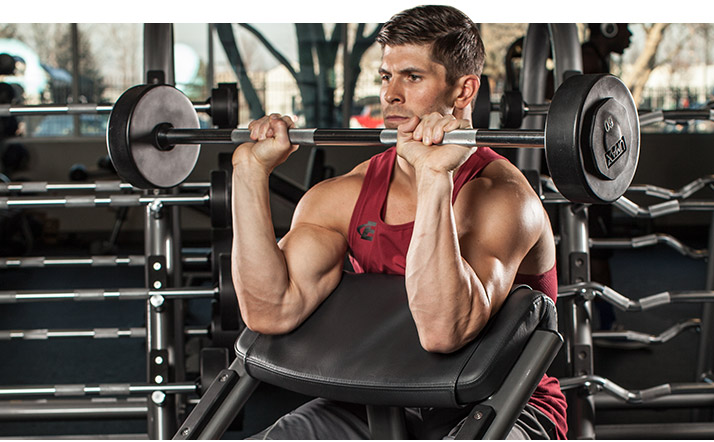Overview
If your forearms are being overpowered by your biceps and triceps, it’s time to bring them to the forefront. Blow up those stubborn lower arms with this battery of exercises and techniques!If you’re farmer, mechanic, baseball player, or any other laborer who completes a lot of physical work with his hands, you probably don’t need to read this. Just flex those monster forearms and click on another article. But if your job doesn’t involve extensive gripping, pulling, extending, or flexing your wrists, then your forearms probably need some attention.Strengthening and building your forearms isn’t just about aesthetics, although we agree that few things look better than well-developed lower arms in a T-shirt. But strengthening your forearms can also help improve your gripping power on a number of full-body exercises and big movements like heavy back exercises and deadlifts. And who doesn’t want to bring up those lifts, too?Building your forearms, however, is a little more complicated than prescribing three exercises for three sets of 8-10 reps. Like the lower legs, the lower arms require a kitchen-sink approach to training. Unless you have a genetic predisposition for big forearms, you’re going to have to throw everything at ’em.
YOUR FOREARMS UNDER THE MICROSCOPE
Not unlike the calves, the muscle groups in your lower arms—the brachioradialis on the top of your forearm near your elbow, and the group of smaller muscles on the top of your arm near your wrist, collectively known as the wrist extensors; and the muscles on the underside, known as the wrist flexors—have a higher degree of slow-twitch muscle fibers than most of the larger skeletal muscle groups like the quads, hamstrings, and chest.Besides the fact that these muscles are very small, and thus have a limited potential for growth, their higher composition of slow-twitch fibers makes them particularly stubborn to grow.
“The forearms and hand muscles can be rather resilient to fatigue, which suggests type I or type IIa muscle fibers, so they require more attention to cause them to adapt,” says Olympic weightlifter and powerlifter Vince Kreipke, MS, CSCS.
Some contend that the gripping involved in various exercises like rows, deadlifts, and shrugs provides enough lower-arm stimulation, but Kreipke argues that, with those exercises, you’re holding the bar isometrically—that is, your wrist maintains a near-neutral position throughout the movement—so there’s little actual movement taking place at the wrists.
“Remember, when training isometrically, the trained muscle experiences adaptations at only that joint angle, and roughly 20 degrees around that joint angle,” he says. “This is why training through a full range of motion is important in any movement. Thus, to get full-range forearm training and build greater size, it’s important to train the different movements outside of simple grip training.”
TRAINING YOUR FOREARMS
Forearm-specific training is the recommended way to fully fatigue the various muscles of the forearm and ensure they’re worked through the entire range of motion. After you complete whatever heavy upper-body work you’re doing for the day, you can do specific movements for the forearms.
If it’s not clear that you should never train your forearms immediately before back or biceps, try it just once and attempt to hold on to a heavy barbell. You probably can’t grip it for very long! For this reason, you should train forearms after back or biceps.Only when you fully flex and fully extend at the wrist joint do the smaller forearm muscles get worked actively through their entire range of motion. That means doing wrist curls to target the flexors (on the palm side), and reverse wrist curls to target the extensors (on the opposite side).
Kreipke says there’s no need to do complicated movements for the flexors and extensors; simple wrist curls off the end of a bench have been effective since Arnold was training. “You just have to make sure that the wrist is flexing. I normally do this movement off a bench or some sort of support,” he says.
However, there’s another larger forearm muscle closer to the elbow, the brachioradialis, that wrist-curl movements don’t target. Though it isn’t engaged during standard biceps curls, it does get worked during neutral-grip movements like hammer curls and overhand-grip exercises like reverse curls.
THE GRITTY DETAILS
When it comes to training your forearms directly,
Perform higher reps: 10-20, with an average of 15 per set
Take less rest between sets: just enough time to allow the burn to subside, rather than a full minute
Train them long and hard: 60-plus reps a workout
“The isometric grip work from your other pulling work—assuming you didn’t use straps—should give you plenty of work in the higher-intensity range [using heavy weights for lower reps],”
“I strongly suggest putting a lot of volume on your forearms if you’re going to focus on them as a muscle group,” he says. “I’d also suggest supersetting opposing movements—wrist curls and reverse wrist curls—to increase the pump. Either way, you’re going to need to blow them up to get size adaptations out of them.”
Like other muscle groups that have a greater percentage of slow-twitch muscle fibers, you can also train the forearms more frequently—up to three times per week, provided you don’t do them the day before a workout that requires a very strong grip.
Experiment with multiple combinations of sets and reps, as well as various intensity boosters, to see what really is most effective for you. As with calf training, you might have to explore multiple approaches to extract gains that come agonizingly slow. With repetition and time, those incremental gains finally become more substantive.
With this knowledge in your grip, try the simple workout below after you train back or biceps, to put some serious size on your lower arms.




